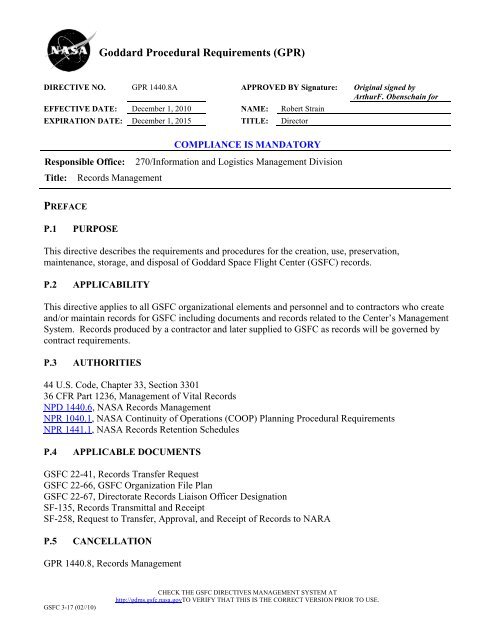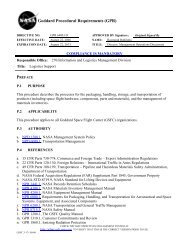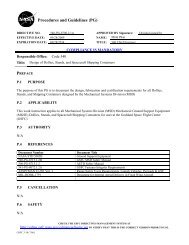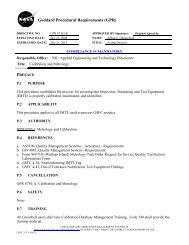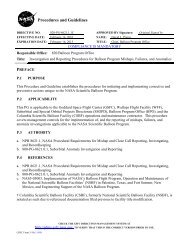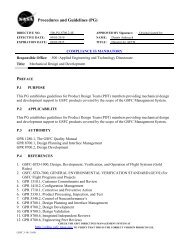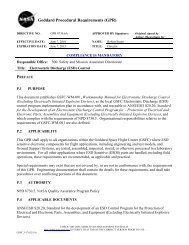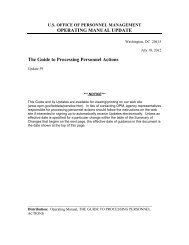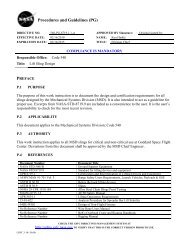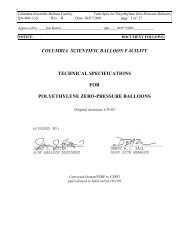Goddard's Records Management - FOIA and eLibrary website! - NASA
Goddard's Records Management - FOIA and eLibrary website! - NASA
Goddard's Records Management - FOIA and eLibrary website! - NASA
Create successful ePaper yourself
Turn your PDF publications into a flip-book with our unique Google optimized e-Paper software.
Goddard Procedural Requirements (GPR)<br />
DIRECTIVE NO. GPR 1440.8A APPROVED BY Signature: Original signed by<br />
ArthurF. Obenschain for<br />
EFFECTIVE DATE: December 1, 2010 NAME: Robert Strain<br />
EXPIRATION DATE: December 1, 2015 TITLE: Director<br />
COMPLIANCE IS MANDATORY<br />
Responsible Office: 270/Information <strong>and</strong> Logistics <strong>Management</strong> Division<br />
Title: <strong>Records</strong> <strong>Management</strong><br />
PREFACE<br />
P.1 PURPOSE<br />
This directive describes the requirements <strong>and</strong> procedures for the creation, use, preservation,<br />
maintenance, storage, <strong>and</strong> disposal of Goddard Space Flight Center (GSFC) records.<br />
P.2 APPLICABILITY<br />
This directive applies to all GSFC organizational elements <strong>and</strong> personnel <strong>and</strong> to contractors who create<br />
<strong>and</strong>/or maintain records for GSFC including documents <strong>and</strong> records related to the Center’s <strong>Management</strong><br />
System. <strong>Records</strong> produced by a contractor <strong>and</strong> later supplied to GSFC as records will be governed by<br />
contract requirements.<br />
P.3 AUTHORITIES<br />
44 U.S. Code, Chapter 33, Section 3301<br />
36 CFR Part 1236, <strong>Management</strong> of Vital <strong>Records</strong><br />
NPD 1440.6, <strong>NASA</strong> <strong>Records</strong> <strong>Management</strong><br />
NPR 1040.1, <strong>NASA</strong> Continuity of Operations (COOP) Planning Procedural Requirements<br />
NPR 1441.1, <strong>NASA</strong> <strong>Records</strong> Retention Schedules<br />
P.4 APPLICABLE DOCUMENTS<br />
GSFC 22-41, <strong>Records</strong> Transfer Request<br />
GSFC 22-66, GSFC Organization File Plan<br />
GSFC 22-67, Directorate <strong>Records</strong> Liaison Officer Designation<br />
SF-135, <strong>Records</strong> Transmittal <strong>and</strong> Receipt<br />
SF-258, Request to Transfer, Approval, <strong>and</strong> Receipt of <strong>Records</strong> to NARA<br />
P.5 CANCELLATION<br />
GPR 1440.8, <strong>Records</strong> <strong>Management</strong><br />
GSFC 3-17 (02//10)<br />
CHECK THE GSFC DIRECTIVES MANAGEMENT SYSTEM AT<br />
http://gdms.gsfc.nasa.govTO VERIFY THAT THIS IS THE CORRECT VERSION PRIOR TO USE.
DIRECTIVE NO. GPR 1440.8A Page 2 of 12<br />
EFFECTIVE DATE: December 1, 2010<br />
EXPIRATION DATE: December 1, 2015<br />
P.6 SAFETY<br />
None<br />
P.7 TRAINING<br />
The Center <strong>Records</strong> Manager shall develop a training program covering general records practices to<br />
provide training <strong>and</strong> periodic briefings to Directorate <strong>Records</strong> Liaison Officers, <strong>Records</strong> Custodians, <strong>and</strong><br />
Greenbelt/WFF personnel.<br />
P.8 RECORDS<br />
Record Title Record Custodian Retention<br />
GSFC 22-66, Organization File<br />
Plan<br />
<strong>Records</strong> Case Files; Transfers,<br />
Retrievals, Disposals, <strong>and</strong><br />
related documentation (SF-<br />
135, SF-258 <strong>and</strong> GSFC 22-41)<br />
<strong>Records</strong> Case Files; Transfers,<br />
Retrievals, Disposals, <strong>and</strong><br />
related documentation (SF-135<br />
<strong>and</strong> GSFC 22-41)<br />
Center <strong>Records</strong> Manager,<br />
<strong>Records</strong> Liaison Officers,<br />
Offices of Record<br />
Center <strong>Records</strong> Manager<br />
All Other Offices<br />
NRRS 1/75E Destroy file plans when<br />
superseded.<br />
NRRS 1/75A1(b) Retain on site <strong>and</strong><br />
destroy when no longer needed for<br />
reference or when 75 years old,<br />
whichever is longer.<br />
NRRS 1/75A1(c) Destroy 6 years<br />
after the related records are destroyed<br />
or transferred to NARA, whichever is<br />
applicable.<br />
Agency Record Reviews <strong>and</strong><br />
Center <strong>Records</strong> Self-<br />
Assessment Files<br />
Center <strong>Records</strong> Manager,<br />
Organization Under<br />
Review/Assessment<br />
*NRRS – <strong>NASA</strong> <strong>Records</strong> Retention Schedules (NPR 1441.1)<br />
NRRS 9/24.5 Close file after closure<br />
of all recommendations. Destroy 3<br />
years after close of file.<br />
P.9 MEASUREMENT/VERIFICATION<br />
The Center <strong>Records</strong> Manager shall initiate an annual call for Directorates to review, revalidate, <strong>and</strong><br />
submit file plans to the <strong>Records</strong> <strong>Management</strong> Program office <strong>and</strong> track completion to ensure each<br />
office of record maintains an up-to-date file plan.<br />
The Center <strong>Records</strong> Manager shall conduct annual self-assessments in accordance with Agency<br />
requirements <strong>and</strong> report results to the Agency <strong>Records</strong> Officer to ensure records management<br />
program objectives <strong>and</strong> requirements are met.<br />
GSFC 3-17 (02//10)<br />
CHECK THE GSFC DIRECTIVES MANAGEMENT SYSTEM AT<br />
http://gdms.gsfc.nasa.govTO VERIFY THAT THIS IS THE CORRECT VERSION PRIOR TO USE.
DIRECTIVE NO. GPR 1440.8A Page 3 of 12<br />
EFFECTIVE DATE: December 1, 2010<br />
EXPIRATION DATE: December 1, 2015<br />
PROCEDURES<br />
In this document, a requirement is identified by “shall,” a good practice by “should,” permission by<br />
“may” or “can,” expectation by “will,” <strong>and</strong> descriptive material by “is.”<br />
1. RESPONSIBILITIES<br />
1.1 The Center Director will ensure that policies <strong>and</strong> practices are established to facilitate the<br />
preservation of records documenting Center business, as performed by both civil service employees <strong>and</strong><br />
support contractors.<br />
1.2 The GSFC Chief Information Officer (CIO) shall, in coordination with the Center <strong>Records</strong><br />
Manager, ensure proper management of electronic records <strong>and</strong> ensure information system design,<br />
development, <strong>and</strong> implementation includes record keeping functionalities.<br />
1.3 The Information <strong>and</strong> Logistics <strong>Management</strong> Division shall institute an efficient <strong>and</strong> effective<br />
record management program at GSFC that ensures compliance with statutory, regulatory, <strong>and</strong> Agency<br />
requirements <strong>and</strong> procedures.<br />
1.4. The GSFC <strong>Records</strong> Manager shall:<br />
a. Oversee the Center records management program, providing technical assistance <strong>and</strong> procedural<br />
advice to GSFC organizations <strong>and</strong> employees responsible for records management functions.<br />
b. Serve as the Agency <strong>Records</strong> Officer’s primary point of contact, providing advice on Center<br />
specific issues, responding to actions, preparing reports, <strong>and</strong> forwarding recommendations for<br />
records retention schedule changes.<br />
c. Authorize routine record transfers to the Washington National <strong>Records</strong> Center (WNRC) on a<br />
SF-135, <strong>Records</strong> Transmittal <strong>and</strong> Receipt <strong>and</strong> GSFC 22-41, <strong>Records</strong> Transfer Request; transfers to<br />
the National Archives <strong>and</strong> <strong>Records</strong> Administration (NARA) on a SF-258, Request to Transfer,<br />
Approval, <strong>and</strong> Receipt of <strong>Records</strong> to NARA; <strong>and</strong> the retrieval, return <strong>and</strong> disposal of records held<br />
at the Federal <strong>Records</strong> Center.<br />
d. Interface with Directorate <strong>Records</strong> Liaison Officers at various organization levels to ensure they are<br />
aware of their records management responsibilities.<br />
e. Develop <strong>and</strong> coordinate a training program to familiarize Center personnel with their records<br />
management responsibilities <strong>and</strong> requirements for the creation, maintenance, <strong>and</strong> disposition of<br />
GSFC records. Provide records management briefings to organizations upon request.<br />
GSFC 3-17 (02//10)<br />
CHECK THE GSFC DIRECTIVES MANAGEMENT SYSTEM AT<br />
http://gdms.gsfc.nasa.govTO VERIFY THAT THIS IS THE CORRECT VERSION PRIOR TO USE.
DIRECTIVE NO. GPR 1440.8A Page 4 of 12<br />
EFFECTIVE DATE: December 1, 2010<br />
EXPIRATION DATE: December 1, 2015<br />
f. Conduct an annual self-assessment of the records management program throughout the Center to<br />
ensure records are identified <strong>and</strong> protected; document discrepancies; communicate instruction for<br />
correction actions; track completion <strong>and</strong> report results to the Agency <strong>Records</strong> Officer.<br />
g. Implement <strong>and</strong> manage the GSFC Vital <strong>Records</strong> Program, in cooperation with the GSFC<br />
Emergency Preparedness Coordinator (EPC) <strong>and</strong> the Emergency <strong>Management</strong> Task Group<br />
(EMTG), to ensure the ready availability of vital records needed for the continued operation of<br />
essential functions during a national or regional emergency. Update vital records in accordance<br />
with the established cycle <strong>and</strong> conduct an annual review of the vital records inventory.<br />
h. Develop communication networks with other federal agencies as necessary.<br />
1.5 Heads of Primary Organizations shall:<br />
a. Designate an individual to serve as the Directorate <strong>Records</strong> Liaison Officer for their respective<br />
organization on a GSFC 22-67, Directorate <strong>Records</strong> Liaison Officer Designation.<br />
b. Institute effective records management practices to carry out the provisions of <strong>NASA</strong> records<br />
management rules.<br />
c. Include records management requirements when planning all technology applications, to determine<br />
what impact, if any, the application will have on the Center’s ability to document its activities.<br />
1.6. Directorate <strong>Records</strong> Liaison Officers shall:<br />
a. Work with the Center <strong>Records</strong> Manager to ensure the proper creation, maintenance, <strong>and</strong> disposition<br />
of all records generated within their respective Directorate.<br />
b. Coordinate with the GSFC <strong>Records</strong> Manager to identify <strong>and</strong> store copies of their organization’s<br />
vital records, including those in the possession of contractors, that would enable the Center to<br />
operate during an emergency/disaster or immediately following one.<br />
c. Conduct annual reviews of their organization’s records to ensure material is current, complete, <strong>and</strong><br />
documented on a GSFC 22-66, GSFC Organization File Plan.<br />
d. Work with the Protective Services Division to ensure only those individuals with the proper<br />
security clearance h<strong>and</strong>le classified records.<br />
e. Interface with records custodians within their primary organization.<br />
f. Assist civil servants <strong>and</strong> contractors to ensure records remain legible, readily available, identifiable,<br />
retrievable <strong>and</strong> stored in a secure cabinet when necessary.<br />
GSFC 3-17 (02//10)<br />
CHECK THE GSFC DIRECTIVES MANAGEMENT SYSTEM AT<br />
http://gdms.gsfc.nasa.govTO VERIFY THAT THIS IS THE CORRECT VERSION PRIOR TO USE.
DIRECTIVE NO. GPR 1440.8A Page 5 of 12<br />
EFFECTIVE DATE: December 1, 2010<br />
EXPIRATION DATE: December 1, 2015<br />
g. Review <strong>and</strong> authorize GSFC 22-41, <strong>Records</strong> Transfer Request for routine record transfers to the<br />
WNRC.<br />
1.7. Employees who create, maintain, <strong>and</strong> use <strong>NASA</strong> records shall:<br />
a. Underst<strong>and</strong> the difference between a record <strong>and</strong> a non-record.<br />
b. Preserve <strong>and</strong> dispose of records, regardless of the medium on which they reside, in accordance with<br />
Agency policy.<br />
c. File personal papers <strong>and</strong> non-record material separately from Center records.<br />
d. Attend training programs sponsored by the Information <strong>and</strong> Logistics <strong>Management</strong> Division to<br />
promote records management practices at Goddard.<br />
e. Ensure records are legible, readily available, identifiable, retrievable <strong>and</strong> stored in a secure cabinet<br />
when necessary<br />
1.8. Contractors shall:<br />
a. Be familiar with Goddard policy regarding records management.<br />
b. Return all applicable records at the conclusion of the contract.<br />
c. Ensure records are legible, readily available, identifiable, retrievable <strong>and</strong> stored in a secure cabinet<br />
when necessary<br />
2. Filing<br />
<strong>Records</strong> shall be physically or electronically filed by a method that ensures records are accessible <strong>and</strong><br />
retrievable by a user. The Agency Filing Scheme (see NPR 1441.1) is the preferred method for filing<br />
records.<br />
<strong>Records</strong> created by GSFC shall be safeguarded:<br />
a. <strong>Records</strong> shall be stored in a manner that minimizes deterioration, damage, loss, <strong>and</strong><br />
unauthorized access.<br />
b. If records have a security classification, they shall be secured in a General Services<br />
Administration approved security container (safe) or approved facility sufficient to preclude<br />
unauthorized access.<br />
GSFC 3-17 (02//10)<br />
CHECK THE GSFC DIRECTIVES MANAGEMENT SYSTEM AT<br />
http://gdms.gsfc.nasa.govTO VERIFY THAT THIS IS THE CORRECT VERSION PRIOR TO USE.
DIRECTIVE NO. GPR 1440.8A Page 6 of 12<br />
EFFECTIVE DATE: December 1, 2010<br />
EXPIRATION DATE: December 1, 2015<br />
c. <strong>Records</strong> that are no longer needed locally to conduct business may be stored at the local Federal<br />
<strong>Records</strong> Center, provided a records retention schedule applies, by completing a GSFC 22-41,<br />
<strong>Records</strong> Transfer Request.<br />
d. File <strong>and</strong> maintain records separately from reference/non-record material.<br />
3. Disposition<br />
<strong>Records</strong> shall be disposed of in accordance with NPR 1441.1. There are two general disposition<br />
categories:<br />
a. Temporary <strong>Records</strong> approved by the National Archives <strong>and</strong> <strong>Records</strong> Administration (NARA) for<br />
disposal, either immediately or after a specified retention period; <strong>and</strong><br />
b. Permanent <strong>Records</strong> that are appraised by NARA as having sufficient historical or other value to<br />
warrant continued preservation by the Federal government beyond the time they are needed by<br />
GSFC for administrative, legal, or fiscal purposes.<br />
In situations where a disposition schedule is not clearly identifiable, GSFC organizations shall contact<br />
the Goddard <strong>Records</strong> Manager for guidance.<br />
4. Destruction<br />
No records shall be destroyed without an approved disposition schedule.<br />
GSFC 3-17 (02//10)<br />
CHECK THE GSFC DIRECTIVES MANAGEMENT SYSTEM AT<br />
http://gdms.gsfc.nasa.govTO VERIFY THAT THIS IS THE CORRECT VERSION PRIOR TO USE.
DIRECTIVE NO. GPR 1440.8A Page 7 of 12<br />
EFFECTIVE DATE: December 1, 2010<br />
EXPIRATION DATE: December 1, 2015<br />
Appendix A – Definitions<br />
A.1 Agency Filing Scheme (AFS) – A list of subject identification codes contained in NPR 1441.1<br />
intended for use in filing <strong>NASA</strong>-owned records.<br />
A.2 Cycle – The periodic removal of obsolete copies of vital records <strong>and</strong> their replacement with<br />
copies of current vital records. This may occur daily, weekly, quarterly, annually or at other designated<br />
intervals.<br />
A.3 Classified <strong>Records</strong> – A record containing classified information that must be protected against<br />
unauthorized disclosure <strong>and</strong> is marked to indicate its classified status when in documentary form.<br />
A.4 Directorate <strong>Records</strong> Liaison Officer – An individual designated by a primary organization to<br />
assist the organization in identifying, maintaining, <strong>and</strong> dispositioning records, <strong>and</strong> interfaces with<br />
records custodians. The <strong>Records</strong> Liaison Officer also serves as the point-of-contact (POC) with the<br />
Goddard <strong>Records</strong> Manager for all records management actions.<br />
A.5 Disaster – An unexpected occurrence inflicting widespread destruction <strong>and</strong> distress <strong>and</strong> having<br />
long-term adverse effects on Center operations.<br />
A.6 Disposition – The action taken regarding records no longer needed in current office space. This<br />
action includes transfer to Federal <strong>Records</strong> Centers, transfer of permanent records to the National<br />
Archives, <strong>and</strong> disposal of temporary records.<br />
A.7 Electronic Record – Any information that is recorded by or in a format that only a computer can<br />
process <strong>and</strong> that satisfies the definition of a Federal record in 36 CFR.<br />
A.8 Emergency – A situation or occurrence of a serious nature, developing suddenly <strong>and</strong><br />
unexpectedly, <strong>and</strong> dem<strong>and</strong>ing immediate action. The scale of an emergency can be local, regional, or<br />
national.<br />
National Emergencies – Any occurrence, including natural disaster, technological<br />
emergency, military attack, or other emergency, that seriously degrades or threatens the<br />
national security of the United States. Response to nationally declared emergencies<br />
(including <strong>NASA</strong> responsibilities) is specified by the Federal Emergency <strong>Management</strong><br />
Agency (FEMA) Federal Response Plan. Only the President of the United States can<br />
declare a National Emergency.<br />
A.9 Emergency <strong>Management</strong> Task Group (EMTG) – A Committee responsible for planning <strong>and</strong><br />
evaluating resources <strong>and</strong> preparing for emergency management at GSFC.<br />
GSFC 3-17 (02//10)<br />
CHECK THE GSFC DIRECTIVES MANAGEMENT SYSTEM AT<br />
http://gdms.gsfc.nasa.govTO VERIFY THAT THIS IS THE CORRECT VERSION PRIOR TO USE.
DIRECTIVE NO. GPR 1440.8A Page 8 of 12<br />
EFFECTIVE DATE: December 1, 2010<br />
EXPIRATION DATE: December 1, 2015<br />
A.10 Emergency Operations Center (EOC) – A specially equipped area that serves as the<br />
communications hub <strong>and</strong> control center from which coordination <strong>and</strong> control is exercised <strong>and</strong><br />
maintained during an emergency.<br />
A.11 Emergency Preparedness Coordinator (EPC) – The individual responsible for managing the<br />
overall Emergency Preparedness Program (EPP). Responsibilities include developing an effective<br />
organizational structure, allocating resources, making appropriate assignments, managing information,<br />
<strong>and</strong> continually striving to improve the effectiveness of the program.<br />
A.12 Federal <strong>Records</strong> Center (FRC) – A storage <strong>and</strong> servicing facility operated by the National<br />
Archives <strong>and</strong> <strong>Records</strong> Administration (NARA) for Federal records pending disposal or transfer to the<br />
National Archives.<br />
A.13 File Plan – a list of all record series maintained by an office that distinguishes between hard<br />
copy <strong>and</strong> electronic records <strong>and</strong> includes the AFS, record series/description, records custodian, file<br />
location, <strong>and</strong> a reference to the approved retention/disposition instructions for each record series<br />
identified.<br />
A.14 Goddard <strong>Records</strong> Manager – Individual appointed by the Center Director designated to oversee<br />
the records management program.<br />
A.15 <strong>NASA</strong> <strong>Records</strong> Retention Schedule (NRRS) – A document providing m<strong>and</strong>atory instruction<br />
pertaining to the retention periods of records of the National Aeronautics <strong>and</strong> Space Administration<br />
(<strong>NASA</strong>).<br />
A.16 National Archives – The repository for records that the Archivist of the United States has<br />
determined to have sufficient historical or other value to warrant their continued preservation by the<br />
Federal Government.<br />
A.17 Non-record – In the same form as records, but having at least one of the following<br />
characteristics:<br />
(1) made or received solely for reference or supply;<br />
(2) containing no significant evidence of activities;<br />
(3) extra copies of records;<br />
(4) work papers, including drafts used to prepare a letter, report, or other finished document;<br />
<strong>and</strong>/or<br />
(5) publications, including library materials.<br />
GSFC 3-17 (02//10)<br />
CHECK THE GSFC DIRECTIVES MANAGEMENT SYSTEM AT<br />
http://gdms.gsfc.nasa.govTO VERIFY THAT THIS IS THE CORRECT VERSION PRIOR TO USE.
DIRECTIVE NO. GPR 1440.8A Page 9 of 12<br />
EFFECTIVE DATE: December 1, 2010<br />
EXPIRATION DATE: December 1, 2015<br />
A.18 Office of Record – An office designated to maintain the record or official copy of a particular<br />
record in an organization.<br />
A.19 Personal Papers – Documentary materials belonging to an individual that are not used to<br />
conduct Agency business. Related solely to an individual's own affairs or used exclusively for that<br />
individual's convenience. Must be clearly designated as such <strong>and</strong> kept separate from the Center's<br />
records.<br />
A.20 Primary Organization – An organization reporting directly to the Center Director.<br />
A.21 Record – All books, papers, maps, photographs, machine readable materials, or other<br />
documentary materials, regardless of physical form or characteristics, made or received by an Agency of<br />
the United States Government <strong>and</strong> needed to document Agency activities or actions. <strong>Records</strong> include,<br />
but are not limited to:<br />
(1) Letters<br />
(2) Completed forms<br />
(3) Memor<strong>and</strong>a<br />
(4) Directives<br />
(5) Reports<br />
A.22 <strong>Records</strong> Custodian – An individual who is responsible for collecting, indexing, accessing, filing,<br />
storing, maintaining, <strong>and</strong> dispositioning a record or collection of records.<br />
A.23 <strong>Records</strong> Retention – M<strong>and</strong>atory instructions for h<strong>and</strong>ling records no longer needed for<br />
immediate government business, with provision of authority for final disposition.<br />
A.24 Record Series – A group of related records filed/used together as a unit <strong>and</strong> evaluated as a unit<br />
for retention purposes, e.g. a personnel file consisting of an application, reference letters, benefit forms,<br />
etc.<br />
A.25 Vital <strong>Records</strong> – Copies of essential Agency documents needed to meet operational<br />
responsibilities under national security emergencies or other emergency conditions <strong>and</strong> also those<br />
records essential to protecting the legal <strong>and</strong> financial rights of the Agency <strong>and</strong> those affected by its<br />
activities. Vital records may be categorized as:<br />
(1) Emergency Operating <strong>Records</strong> – Those records essential to the continued functioning or<br />
reconstruction of an organization during <strong>and</strong> after an emergency. Some examples include the<br />
emergency plan itself, directive(s), orders of succession <strong>and</strong> delegations of authority, staffing<br />
GSFC 3-17 (02//10)<br />
CHECK THE GSFC DIRECTIVES MANAGEMENT SYSTEM AT<br />
http://gdms.gsfc.nasa.govTO VERIFY THAT THIS IS THE CORRECT VERSION PRIOR TO USE.
DIRECTIVE NO. GPR 1440.8A Page 10 of 12<br />
EFFECTIVE DATE: December 1, 2010<br />
EXPIRATION DATE: December 1, 2015<br />
assignments, equipment inventories, vital records inventories, facility engineering design plans<br />
<strong>and</strong> drawings, Emergency Operations Center access credentials, <strong>and</strong> classified or restricted<br />
access documentation.<br />
(2) Legal <strong>and</strong> Financial Rights <strong>Records</strong> – Those records essential to protect the legal <strong>and</strong> financial<br />
rights of individuals in cases where GSFC is the office of record, or where <strong>NASA</strong> records are<br />
the indispensable <strong>and</strong> exclusive source from which individuals may secure or preserve their<br />
rights <strong>and</strong> interests. Examples include accounts receivable records, social security records,<br />
payroll records, retirement records, <strong>and</strong> insurance records. These records were formerly defined<br />
as "rights-<strong>and</strong>-interests" records.<br />
GSFC 3-17 (02//10)<br />
CHECK THE GSFC DIRECTIVES MANAGEMENT SYSTEM AT<br />
http://gdms.gsfc.nasa.govTO VERIFY THAT THIS IS THE CORRECT VERSION PRIOR TO USE.
DIRECTIVE NO. GPR 1440.8A Page 11 of 12<br />
EFFECTIVE DATE: December 1, 2010<br />
EXPIRATION DATE: December 1, 2015<br />
Appendix B – Acronyms<br />
AFS<br />
CFR<br />
CIO<br />
COOP<br />
EMTG<br />
EOC<br />
EPC<br />
EPP<br />
FEMA<br />
FMD<br />
FRC<br />
GDMS<br />
GSFC<br />
ILMD<br />
ISO<br />
NARA<br />
<strong>NASA</strong><br />
NPD<br />
NPR<br />
NRRS<br />
POC<br />
WFF<br />
Agency Filing Scheme<br />
Code of Federal Regulations<br />
Chief Information Office<br />
Continuity of Operations<br />
Emergency <strong>Management</strong> Task Group<br />
Emergency Operations Center<br />
Emergency Preparedness Coordinator<br />
Emergency Preparedness Program<br />
Federal Emergency <strong>Management</strong> Agency<br />
Facilities <strong>Management</strong> Division<br />
Federal <strong>Records</strong> Center<br />
Goddard Directives <strong>Management</strong> System<br />
Goddard Space Flight Center<br />
Information <strong>and</strong> Logistics <strong>Management</strong> Division<br />
International Organization for St<strong>and</strong>ardization<br />
National Archives <strong>and</strong> <strong>Records</strong> Administration<br />
National Aeronautics <strong>and</strong> Space Administration<br />
<strong>NASA</strong> Policy Directive<br />
<strong>NASA</strong> Procedural Requirements<br />
<strong>NASA</strong> <strong>Records</strong> Retention Schedules<br />
Point of Contact<br />
Wallops Flight Facility<br />
GSFC 3-17 (02//10)<br />
CHECK THE GSFC DIRECTIVES MANAGEMENT SYSTEM AT<br />
http://gdms.gsfc.nasa.govTO VERIFY THAT THIS IS THE CORRECT VERSION PRIOR TO USE.
DIRECTIVE NO. GPR 1440.8A Page 12 of 12<br />
EFFECTIVE DATE: December 1, 2010<br />
EXPIRATION DATE: December 1, 2015<br />
CHANGE HISTORY LOG<br />
Revision Effective Date Description of Changes<br />
Baseline 04/11/05 Initial Release<br />
08/08/06<br />
01/19/10<br />
A 12/01/10<br />
Administratively updated to reflect a change in the owning<br />
organization code from 230 to 270.<br />
Administratively extended for 1 year from original expiration<br />
date.<br />
Revised to ensure compliance with ISO requirements <strong>and</strong><br />
make administrative adjustments.<br />
GSFC 3-17 (02//10)<br />
CHECK THE GSFC DIRECTIVES MANAGEMENT SYSTEM AT<br />
http://gdms.gsfc.nasa.govTO VERIFY THAT THIS IS THE CORRECT VERSION PRIOR TO USE.


